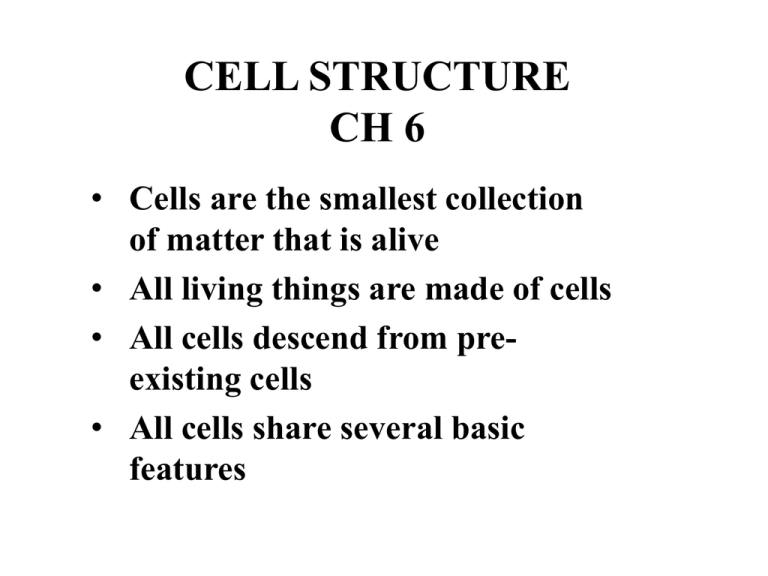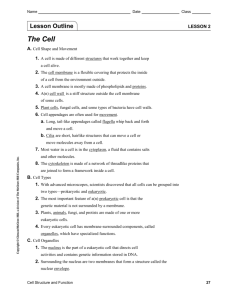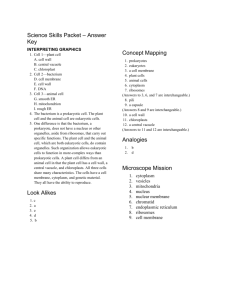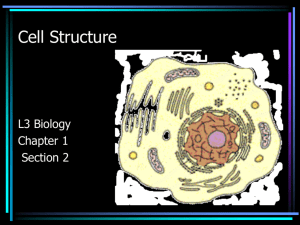CELL STRUCTURE CH 6
advertisement

CELL STRUCTURE CH 6 • Cells are the smallest collection of matter that is alive • All living things are made of cells • All cells descend from preexisting cells • All cells share several basic features I. Why are cells so small? A. The surface – to – volume theory • Metabolic requirements limit cell size • Surface area to volume ratio of a cell is critical to its metabolic efficiency • Surface area increases by n2 while volume increases by n3 • Smaller cells have a larger surface area to volume ratio B. How cells can increase in size without decreasing the SA/V ratio: • increase their surface area or decrease their volume o Organelles o Plant cells : large central vacuole o Nerve cells: long skinny extensions o Intestinal cells: highly folded cell membrane II. Prokaryotic cells vs Eukaryotic cells A. Prokaryotic cells • No nucleus or organelles • Circular DNA in a nucleoid region • Cytoplasm and ribosomes surrounded by cell membrane B. Eukaryotic cells • Have linear chromosomes in nucleus • Organelles • Bigger than prokaryotic cells C. All cells have: • Cell membrane to let things in and out • Ribosomes for protein synthesis • Cytoplasm where many enzymatic reactions occur • Chromosomes that contain genes D. Cell wall: protection and support • • • • in prokaryotic and some eukaryotic cells cellulose in plants chitin in fungi peptidoglycan in bacteria (not archaea) III. A Tour of Eukaryotic Cells • Eukaryotic cells have internal membranes forming organelles • This localizes cellular activities to different parts of cell • All eukaryotic cells have nearly the same organelles prokaryote Nucleus ER Golgi Mitochondri a Chloroplast lysosome ribosomes Cell membrane Cell wall Central vacuole cytoskeleton Plant Animal Fungus Protist* A. The endomembrane system is composed of the nucleus, ER, Golgi, lysosomes, vacuoles, and cell membrane 1. Evolution most widely accepted model is thru invagination of the cell membrane 2. nucleus • contains most of the cell’s DNA • surrounded by nuclear envelope that is double membrane with pores • contains chromosomes and nucleolus (synthesize ribosomal RNA) • pores regulate what enters and leaves • What enters and leaves? • RNA that leaves nucleus is used by ribosome to make protein – Free ribosomes are in cytoplasm and make proteins that stay in cytoplasm – Bound ribosomes are on RER and make membrane bound proteins or proteins that leave the cell 3. endoplasmic reticulum (ER): the cell’s factory • highly folded membrane continuous with nuclear membrane • types – rough ER (RER) • membrane is studded with ribosomes • it helps synthesize and modify proteins that will be transported – smooth ER (SER) • no ribosomes on it • it synthesizes carbs and lipids • it detoxifies drugs 4. Golgi apparatus: shipping and receiving • Flatted stack of membranes found near the RER • It receives proteins from the RER and packages them for transport out of the cell 5. Lysosomes: digesting center • membrane bound organelles with digestive enzymes in acidic environment – digest macromolecules (phagocytosis) – digest and recycle old organelles (autophagy) – digest bacteria and viruses – digest cells destined to be destroyed (apoptosis) 6. Vacuoles: storage depots • Derived from ER and Golgi • Central vacuole in plants stores water and gives plant cell its rigid shape B. Mitochondria and Chloroplasts: convert energy from one form to another 1. mitochondria • double membraned organelle where the inner membrane is folded into cristae • site of ATP synthesis via aerobic respiration • purpose of cristae? 2. chloroplast • double membraned organelle which contains stacks of membrane sacs (thylakoids) called grana • contain chlorophyll • use the energy from the sun to make a precursor to glucose by photosynthesis • purpose of thylakoids? 3. Evolutionary Origins of Mitochondria and Chloroplasts: Endosymbiont theory • Ancestral eukaryote engulfed prokaryotic aerobe and prokaryotic autotroph and they coexisted • Have similarities with bacteria – Have ribosomes and DNA similar in size and structure to bacteria – Same size – Divide independently from rest of cell http://www.sumanasinc.com/webcontent/animations/conten t/organelles.html









